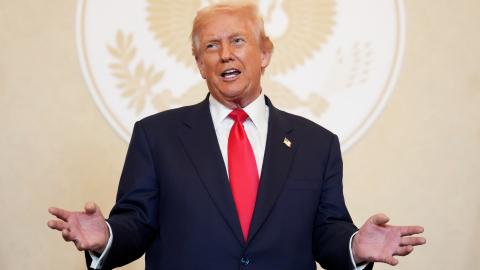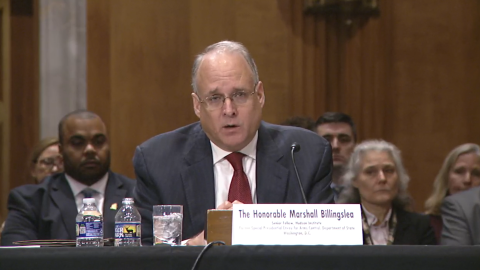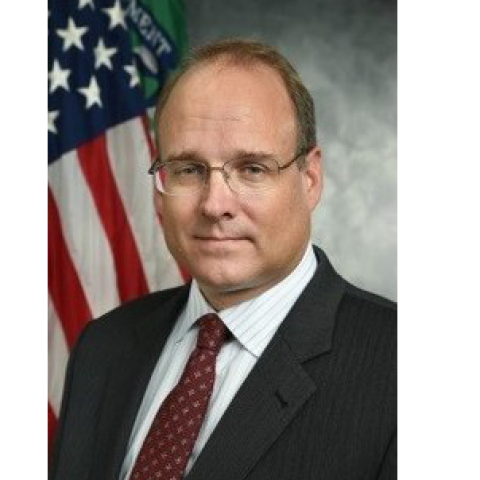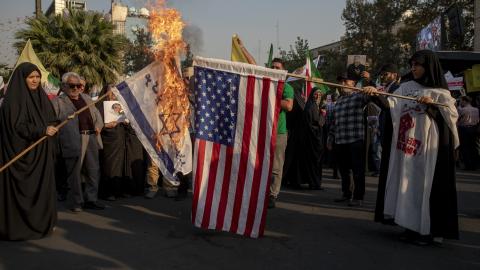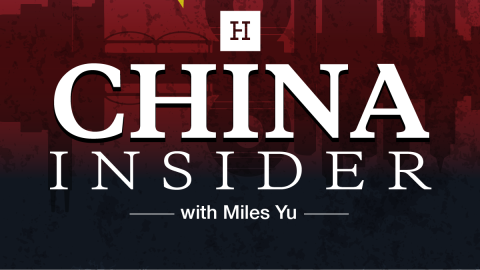In this week’s episode of China Insider, Miles Yu discusses the Dalai Lama’s ninetieth birthday, and how his succession may affect the future of Tibetan Buddhism, culture, and identity as the people face aggressive Chinese Communist Party interference. Next, Miles unpacks the extended docking of the Shandong carrier fleet in Hong Kong and highlights the significance of the local celebrations hosted by the CCP government in Hong Kong. Lastly, Miles details the preparations for China’s eightieth anniversary of its victory in World War II, and examines the importance of the monthslong celebrations to bolster CCP legitimacy.
China Insider is a weekly podcast project from Hudson Institute’s China Center, hosted by China Center Director and Senior Fellow, Dr. Miles Yu, who provides weekly news that mainstream American outlets often miss, as well as in-depth commentary and analysis on the China challenge and the free world’s future.
Episode Transcript
This transcription is automatically generated and edited lightly for accuracy. Please excuse any errors.
Miles Yu:
Welcome to China Insider, a podcast from the Hudson Institute’s China Center. I am Miles Yu, senior fellow and director of the China Center. Join me each week for our analysis of the major events concerning China, China threat, and their implications to the US and beyond.
Colin Tessier-Kay:
It is Tuesday, July 15th, and we have three topics this week. First, we discuss the future of Tibet under Chinese occupation as Tenzin Gyatso (丹增嘉措), the 14th Dalai Lama and spiritual leader of Tibetan Buddhism turns 90. Second, we unpack the significance behind the PLA Navy carrier, Shandong extended docking from Victoria Harbor in Hong Kong, and we look to unpack the significance behind the fleet’s port at the Stonecutters Island Naval base. Lastly, we discussed the CCP’s preparations for the upcoming 80th anniversary of World War II victory and the significance of the annual celebration to CCP leadership and legitimacy. Miles, great to be with you again this week.
Miles Yu:
Colin. So glad to be with you again this week.
Colin Tessier-Kay:
Well, first up this week, the Dalai Lama turned 90 earlier this month and was celebrated by thousands of followers in a week-long event in Dharamsala and Kathmandu in attendance were the democratically elected Tibetan government in exile, as well as several global celebrities and cultural icons. Several state dignitaries such as Indian Prime Minister Nora Modi and Secretary of State Marco Rubio sent wishes to the Tibetan Buddhist leader. Miles, could you start us off with some of the background to the significance of the Dalai Lama in global politics and how the CCP views his role, particularly in Tibetan culture and state affairs?
Miles Yu:
Dalai Lama, as you said, is a spiritual leader of Tibetan, but he’s not a politician. However, everything related to religion is political in China. China just treats him nothing but a politician, as a separatist. They use all kinds of slurs against him. Dalai Lama is an extraordinary individual. I mean, he is not just [the] leader of [the] Tibetan people. He’s a global phenomenon because he represents something that’s very ecumenical, very universal and cosmopolitan. His advocacy for nonviolent resistance. His advocacy for human compassions. He’s not just shouting. He’s using his power to morally persuade people, politicians, [and] communists alike. He’s a very humble but powerful monk. For that, he is basically a thorn in the eyes of the Chinese Communist Party who really, really harbors nothing but hostility toward religions. For decades and decades, China has extraordinary pressure on Tibet and try to eradicate the inference, even the physical image of Dalai Lama, but they failed miserably. That shows you the power of a spiritual uprightness represented here by Dalai Lama. So, happy birthday.
Colin Tessier-Kay:
Happy birthday indeed. While the Dalai Lama said he plans to live to 130 at that, his birthday garnered attention from many about his potential successor. In the past, the Dalai Lama claimed his successor would be born in the free world outside of China and would reincarnate as part of the Tibetan Buddhist teachings. The growing concern, however, is that Beijing will look to appoint the next spiritual leader of Tibetan Buddhism, noting they would reject anyone chosen without their consent. Miles, while this is obviously a matter of spiritual leadership, what is the Dalai Lama’s role in Tibetan Chinese politics and what exactly is the functional authority of the CCP here to interfere in the succession process?
Miles Yu:
You see, religious succession is purely a religious matter based upon the ritual tradition and doctrinal description of that particular religion. Buddhism is no exception. Unlike some other religious leaders like the late Pope Francis, Dalai Lama did not bow to Chinese pressure. He would not yield his power and his legitimate power to reincarnate his successor. That’s basically according to Buddhist teaching. It’s the core of a Buddhist teaching and at least the Tibetan version of Buddhism. That’s why Dalai Lama insisted that he and he alone should have the power to reincarnate [and] designate his successor according to Buddhist teachings. The Chinese Communist Party basically is [a] communist party. We have to understand Chinese communism is communism. All communist teachings basically believe that all organized religions such as Buddhism, Catholicism, Judaism, they are the opiate of the people, they are poisons. That’s why I think Dalai Lama right now has made it very clear he’s not going to bow to the Chinese Communist Party’s attempt to eradicate his inference and his legitimacy to designate his successor. That’s very good for the longevity of the Tibetan Buddhism. Dalai Lama did so with great dignity.
Colin, I grew up in the province right next to Tibet in China, Sichuan province. When I was growing up, from time to time we have visitors from Tibet. The Tibetan people, they’re very culturally, linguistically, and even psychologically, I would say, distinctive from the Han Chinese of which I’m a member. They all treat adversity [and] discrimination with smiling face[s] and with dignity. Dignity and psychological mental ease to deal with adversity and hostility is a hallmark of the power, [the] spiritual power of the Dalai Lama. The amazing thing is the Chinese Communist Party has practiced all kind of draconian measures in Tibet trying to eradicate any reference and inference to Dalai Lama, and they have failed miserably. You will always say Chinese communist indoctrination is powerful and totalitarian. That’s true, but it did not work and has not worked in Tibet.
This is really interesting because [of] this irony of history. You look at what’s going on inside China, the draconian, really brutal methods of repression in places like Xinjiang and Mongolia, even inner Mongolia, almost all of them, the methods tactics have been first invented and practiced by the CCP in Tibet. You look at Xinjiang’s concentration camps [and] the systematic indoctrination of the Uyghurs. They started the in Tibet. That’s why we should have a shout out to the people of Tibet and particularly to the Dalai Lama, for their resilience, for their really, really unbridled thirst for liberty and freedom. That’s why it is very important to celebrate the birth of Dalai Lama. It’s not just to personal glory is to the spirit of resistance to oppression and repression. I think Dalai Lama is an amazing individual, and I’m a big fan of his.
Colin Tessier-Kay:
Absolutely. Like you mentioned, the Dalai Lama and the democratically elected Tibetan government in exile were forced out in 1949, 1950 by Chinese troops and have since spent more than seven decades in exile sustaining the Tibetan culture and identity all during that time. While it doesn’t seem like the current Tibetan struggle for autonomy and opposition of China’s control of Tibetan will change course anytime soon, Miles, what exactly does the future hold here for Tibetans?
Miles Yu:
Yeah, just a little bit of correction. The Chinese communist troops occupied Tibet pretty much in the winter of 1949 and 1950. For about another 10 years or so, they continued to occupy Tibet. In 1959, Tibetans rebelled against Chinese occupation. They failed and they made a brutal suppression. Dalai Lama led a small fraction of his people and fled to India for safety, and that’s where they stay in Dharamsala, in the foothillsof Tibet on the Indian side, and the Indian government [was] kindly enough to provide Dalai Lama a sanctuary space, a safe haven for its government in exile since 1959. That’s the reason why China-India [relations] started to become very, very tense because China does not like Indian government’s measure [and] movement to provide help and protection to Dalai Lama.
You asked about the future of Tibet. I think Dalai Lama is advocating for something called the “middle way”. In other words, he’s not going to advocate for outright independence from Chinese government control. He is advocating for genuine Tibetan autonomy as promised by [the] Chinese government in the 1950s. Tibetan is officially called “Tibetan areas” or called by the Chinese government as [the] “Tibetan autonomous region”. That’s just fake because there’s no real autonomy. Tibet is in the firm grips of the Chinese Communist Party. There’s no independence at all. That’s why Dalai Lama’s advocacy for genuine autonomy poses such a threat to the Chinese government’s narrative because the regime rules China, Tibet, and other regions through lies and falsities. This is one of the very good examples. That’s why Dalai Lama is a very smart guy. He knows how to poke the bubble of the Chinese mendacity.
Colin Tessier-Kay:
Turning to our next topic this week, the PLA Navy Shandong carrier fleet made port in Victoria Harbor for an extended five day docking at the Stonecutters Island Naval Base in Hong Kong. During the fleet stay reports indicate roughly 30,000 people visited the naval vessels. The stay concluded, I should say, with a farewell ceremony organized by the Chinese government in Hong Kong, including an appreciation event, photo session, and with locals and student representatives gathering to thank them for their support. Miles, what can we make of this informal fleet week, if you will, for the PLA navy in Hong Kong? And why the pomp and circumstance?
Miles Yu:
Well, the pomp and circumstance are very typical of the communist pageantry. They do have this habit of presenting something that’s really pompous and very important because they’re good at this is propaganda basically mostly for the consumption of the domestic audience. To be honest with you, I believe this is in response to the large-scale US Filipino naval exercise in the South China Sea. As you can see, there will be very strong and big, I mean even huge, joint exercises in South China Sea among the naval forces of the United States, Australia, Japan, and the Philippines. This is very important. China had to respond to this to show its intransigencyand its defiance. It is a carefully choreographed demonstration of China’s political will. Of course, the flotilla that docked in Hong Kong harbor for a week also [was] led by the Chinese second carrier, the Shandong. The Shandong is a very, very peculiar vessel. It’s basically, mostly a training vessel for the Chinese nascent carrier fleet. It’s not really that [a] big deal, but China makes [it] a huge deal as if China’s carrier capabilities is on par with that of the United States, which is basically the false.
Colin Tessier-Kay:
Yeah, I’m glad you brought that up because along with the joint training exercises, we spoke a few weeks ago on the show about the Shandong fleet operations sailing beyond the first island chain in the Indo-Pacific alongside the Liaoning carrier. While both of those have been pivotal to the CCP’s Indo-Pacific maritime strategy and gray zone operations against several Indo-Pacific nations, the Shandong has seemingly become more of the public facing flagship for the PLA and [the] CCP to generate domestic calls for Chinese military nationalism. So, Miles, what is the significance of the Shandong carrier to the PLA Navy and what role does it primarily serve in China’s maritime operations right now?
Miles Yu:
Well, [the] Shandong Carrier is built as the first Chinese domestically built carrier. That is not entirely true because the first carrier, of course, was a Soviet design and half-finished Varyagand China called it Liaoning. That was refitted by the Chinese Navy. Basically, Shandong is pretty much the same design. It is a mid-size carrier. It’s designed with a ski jump. The reason why there’s a ski jump [is] because they have limited take of power, lifting power. That’s why you need the ski jump. The aircraft is used basically as a J-15. That is a very heavy aircraft for a ship borne operation. That means several things. Number one, it has a very limited takeoff weight, particularly the payload because it’s so big. Another thing is it’s small and it does not have a sustainable proportion power, which is conventional. The Chinese carriers are not nuclear [powered]. All US carriers, super carriers, are much bigger than the Chinese [carrier]. All of the 11 US carriers are nuclear-powered, and they can go as long as they want. The Shandong’s operational range is very limited. It burns about 20,000 tons of fuel every five, six days, and it really does not have a long-distance fuel and provision operational capability. That’s why its utility as a fighting vessel is very limited in comparison to the US carrier capability. It’s basically used by the Chinese Navy as a training ship for the future of development. But the Chinese, of course, like all communist regimes, make this such as if it’s a huge deal. It’s not a bad ship, but overall, in comparison to the United States, it’s at least 20 years behind.
Colin Tessier-Kay:
I think that’s important context to keep in mind, especially for the order of battle and as you introduce conversations of naval capacities between the US and China. But turning to the domestic portion of that event, Chinese media coverage of it framed the visit to Hong Kong as a means to allow residents to witness the PLA Navy’s enhanced maritime defense capabilities and its commitment to safeguarding the nation to instill a greater sense of security among the people. The Shandong is a symbol of the PLA Navy as a powerful deterrent, they claim, to any malign foreign influence. Miles, I’d like to ask clearly there’s an intent on behalf of the CCP here to promote the PLA in Hong Kong, specifically. With attention to this matter, what is the effect of these celebrations on Hong Kong and the people?
Miles Yu:
In Hong Kong, basically, the city that has gone as an international hub of open commerce and free flow of information. Hong Kong has been taken over by the Chinese Communist Party and it ruined its status as a free port. To save Hong Kong as an international commerce [hub], the Chinese Communist Party basically sent this thing over there to boost Hong Kong as some city that’s in decline but backed by the powerful central government in Beijing. I don’t think that really works to salvage Hong Kong’s reputation because the more Beijing exerts its power, even simple power over Hong Kong, the less likely Hong Kong will recover from its devastating loss to the Chinese Communist Party rule. That’s why I think it’s counterproductive. However, domestically, of course, it will enhance China’s coerced sense of pride and glory. If the Shandong represents the epitome of Chinese naval power, I think that the Chinese Communist Party leadership probably should think twice.
Colin Tessier-Kay:
Sticking with the theme of celebrations and military celebrations. As we turn to our last topic for today, the CCP announced earlier this month that preparations were underway for the 80th anniversary of China’s World War II victory. Celebrations stated include dedicated exhibitions at the National Art Museums around the country, including a kickoff event at the Museum of the War of Chinese People’s Resistance Against Japanese Aggression. Full museum title there. Besides the exhibitions, a number of films, television dramas, documentaries and online content are stated to be released over the next month of July to commemorate the occasion. If that wasn’t enough, during the entirety of August to October, there will be a series of stage performances with 40 total productions around Beijing as well as planned military parade on September 3rd in recognition of the end of both the second Sino-Japanese War and World War II. So, Miles, why is the CCP so invested in the month-long commemoration of the victory in World War II?
Miles Yu:
Because it is super sensitive about the legitimacy and [the] very foundation of the Communist Party rule. You see, the Chinese Communist Party lives in lies and false narratives. There’s no bigger lie than Chinese Communist Party’s claim that it was the leading force of resisting against the Japanese vis-a-vis the Nationalist government led by Generalissimo Chiang Kai-Shek (蒋介石). It was absolutely falsehood that the CCP was the mainstay fighting force against Japanese. In order to not embarrass itself so wholly and humiliatingly at the anniversary of the end of World War II, the Chinese Communist Party has audacity to perform the act of leading force during World War II against Japan. Now, let me just put this in perspective. The Chinese Communist Party did not fight the Japanese as the main mission during World War II.
All you have to remember are two critical dates. One is August 24th, 1939. That was the day the Soviet Union and the Nazi Germany signed a non-aggression pact. Hitler and Stalin suddenly became allies. Following that order, the Chinese Communist Party was really, really happy about that. They actually sent cables and the public editorials celebrating the signing because they now know that the Western democracies were facing the two most powerful enemies that was [the] Nazis and the Soviet Communists. The party in Yan’an under Mao (毛泽东) was really happy about that. As a result, because Germany suddenly became Soviet Union’s friend, guess who is German’s friend by treaty? Japan. Under order from Soviet Union, Japan would no longer become the enemy of the Chinese Communist Party, even though Japan had been with war with China, against [the] Chinese and Nationalist government for two years. That’s why the Chinese Communist Party did not fight against Japan at all.
Now, another date to remember is April 13th, 1941. That was two months before the Nazi betrayal of the Soviet-Nazi non-aggression pact by launching the operation Barbarossa against [the] Soviet Union. However, on that day, two months before Nazi betrayal, the Soviet Union and Japan signed a neutrality pact. Since April 13th, 1941, the Soviet Union and Japan are non-combatants. They are not supposed to fight against each other. The Chinese Communist Party throughout the entire war since April 1941 has never fought seriously against [the] Japanese. That’s basically because the Soviet Union did not want the Chinese Communist Party to betray the Soviet-Japan neutrality pact. This is basically the big picture.
Now, Xi Jinping (习近平) went to Yan’an last week and had this really supreme performance of laying the wreath to commemorate the so-called Hundred Regiment campaign, which was launched by the Chinese Communist Party military against the Japanese. It absolutely faked the statistics. It says it eliminated basically 46,000 Japanese troops in northern China. That is a bold-faced lie. According to Japanese own very detailed casualty accounts, not 46,000 as the Chinese Communist Party said, rather is somewhere around less than 500 Japanese were killed and wounded in that so-called Hundred Regiment campaign. I have the exact number here. The Japanese killed 467, 33 [went] missing, and 251 [was] wounded. So, the total casualty suffered by the Japanese [is] about 751. That was the only serious campaign that the Chinese Communist Party fought against Japanese. The rest of the war, 99% of them, were conducted by non-communist forces led by the Chinese Nationalist government under Chiang Kai-Shek, which is officially recognized by the US government. This is absolutely crazy. Now, throughout the entire war, northern China was officially occupied by the Japanese, but also unofficially occupied by the Chinese Communist Party. The Chinese Communist Party fought really hard against any penetration of the Nationalist government in northern China. If [the] Chinese Communist Party and the Japanese occupied forces in northern China both claim occupying that area, there is only one conclusion, that is, they coexisted, [and] they never fought against each other. That is the big picture.
Colin, I’m a World War II historian and I wrote a book about this many years ago. This is absolutely, really bizarre for Xi Jinping to continue this falsehood that somehow the Chinese Communist Party was the leader of China’s anti-Japanese forces. This is actually very, very appalling. The curious thing is the KMT (Kuomintang) party in Taiwan right now should have the legitimacy, [and they] should have the glory to represent the Chinese forces against Japanese because its former leader Chiang-Kai Shek organized, I say, 99% of the campaign against the Japanese during the war. The KMT right now is very CCP-friendly right now. That’s a tragedy of history. I think KMT, the hardcore KMT members, should really wake up and claim its rightful place in history on this particular matter. I think for Xi Jinping to stage a really pompous September 3rd parade commemorating the defeat of Japan, the signing of the peace treaty, surrender with the Japanese, is really, really interesting because Xi Jinping doesn’t deserve this at all.
Colin Tessier-Kay:
Yeah, I’m really glad you brought all that up because no one’s going to sneak any World War II history by you. I’d like to kind of round out today’s conversation by asking, given the significance of this history for CCP legitimacy, it’s clear why they would invest a great deal into these celebrations if only to maintain a strong nationalist discourse domestically, and particularly as it involves Xi Jinping and his both control over the CCP as the party and domestically among the Chinese citizenry, what is at stake here for both him and the party, and is there anything we should be paying attention to over the next few months as we monitor the celebrations?
Miles Yu:
Well, we should keep in mind that the Japanese war cost the life about the 20 to 25 million Chinese people during World War II. However, the Chinese Communist Party is responsible for the lives of about 70 to 75 million people in China in peacetime. So, the real tragedy of China on a much larger scale is the repression and brutal dictatorship of [the] Chinese Communist Party. For China to stage such a pretentious, ostentatious celebration of the end of the war in 1945, we should really have a commemoration for the 70 to 75 million souls perished under [the] Chinese Communist Party. That’s the real history, and we should really keep that in mind.
Now, there’s also another interesting part of that. I think Xi Jinping’s decision to make this such a big deal is really to catch up with what’s going on in Russia because during World War II Russia suffered most casualties. Close to half of the World War II casualties were Russians and Soviet citizens. [The] Putin regime really cleaned its legitimacy on the glory of the defeat of Nazi Germany and also the sacrifice of Soviet citizens in the war. It is legitimate because Russian did fight [the] Nazis and Russia played [a] critical role in the defeat of [the] Nazi regime. Xi Jinping and Putin, they want to get together to celebrate the same kind of defeat, but Xi Jinping has nothing to claim. That’s why he created a new false narrative, organized the entire propaganda machine inside China to push the lie that somehow the Chinese Communist Party was the leading force against Japan during World War II. Again, that was not true.
Colin Tessier-Kay:
Well, that’s our time for this week. Thank you very much to our listeners, and thank you, Miles, for another great drilling conversation this week. Looking forward to speaking with you again next week.
Miles Yu:
Alright, see you next week.
